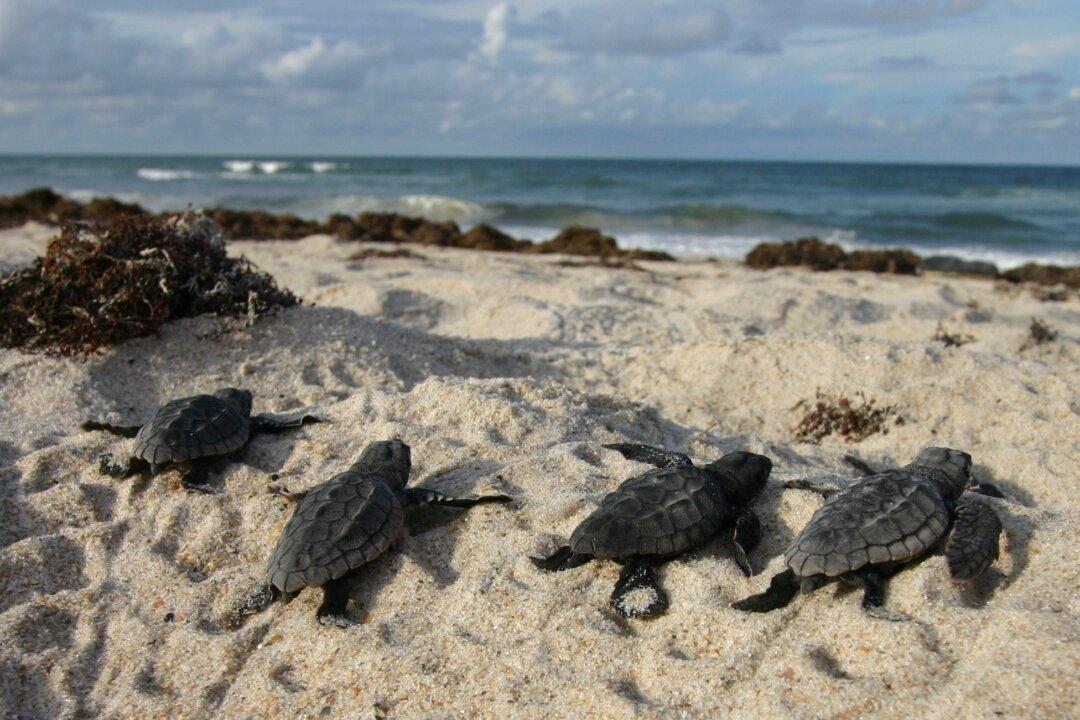Florida saw a record number of sea turtle nests in 2023 despite Hurricane Idalia, beach erosion, and other environmental threats.
Loggerheads, the most common sea turtle in the United States, created 134,040 nests in Florida this year, outpacing the record from 2016. Green turtles had 76,645 nests, which broke the previous record from 2017.
Leatherbacks, the largest sea turtle worldwide, which can weigh over a ton at peak maturity, accounted for 1,711 nests. Kemp’s Ridley turtles, the rarest in the United States, only had 10 nests across Florida in 2023.
While states like North Carolina, Georgia, Alabama, and South Carolina also had high numbers of turtle nests, they did not break historical records like Florida. There are three other sea turtle species worldwide: hawksbill, olive Ridley, and Australian flatbacks.
Florida’s turtle nests are tracked by biologists across the state who report the numbers to the Florida Fish and Wildlife Conservation Commission (FWC).
Justin Perrault, the vice president of research at Loggerhead Marinelife Center (LMC) in Juno Beach, said the biggest threats to sea turtles are rising sea levels, habitat loss, and global climate changes.
When water temperatures increase, sand temperatures along beaches increase, resulting in fewer male hatchlings and more female sea turtles. This is less than ideal for population retention.
However, Mr. Perrault said 100 percent of the turtles treated at the LMC sea turtle hospital have plastic in their digestive tracts.
While the plastic can sometimes pass through the gut of larger turtles, smaller turtles are more vulnerable because they feed “on anything that they can find. If they’re eating a lot of this plastic, it’s going to cause impaction of the gut [and] it’s gonna cause nutrient loss.
“And, sometimes, it can even cause perforation of the GI tract ... leading to infection and loss of nutrient absorption,” he said.
Other Sea Turtle Threats
Like manatees, sea turtles are also susceptible to boat strike injuries, which the staff at LMC see often, he said.But one of the most common and wide-reaching threats to sea turtle populations is artificial light.
“The turtles crawl away from dark silhouettes, which should be the dune, then they crawl towards the brightest horizon, which should have the reflection of the moon and stars.
“So, when you’ve got artificial lighting that’s landward it can confuse a lot of these turtles and can go either east or west, depending on what coast you’re on. So they'll crawl in the wrong direction,” Mr. Perrault said.
The Clearwater Marine Aquarium (CMA) calls these interactions between turtles and man-made light “disorientation events” and observed nearly 100 this year alone.
Beachgoers are encouraged to call the FWC and report incidents of flashlight use near turtles during nesting season, which lasts from April until October in Florida.
Pinellas County, the home of CMA, is one of the most densely populated counties in the Sunshine State. The turtle nests along its beaches are particularly threatened by artificial light.

A green turtle crawls on a Florida beach toward the ocean. Courtesy of FWC
Despite the record-breaking year across the state, the 21 miles of beaches monitored by CMA have seen a decrease in nests since 2022. This year, 227 nests were observed compared to 313 the year prior.
Hurricane Idalia, which struck Florida’s Big Bend region in early September, was partly to blame. Of the 75 nests CMA observed before the storm, only 14 remained after it passed over.
“Unfortunately, the nests pre-Idalia were almost all lost due to the high tides and flooding on our barrier islands,” said Carly Oakley, senior biologist of the Sea Turtle Conservation Program at CMA, in a Nov. 9 news release.
“Female sea turtles lay multiple nests in one season. In each nest, there can be anywhere between 80-120 eggs. After the season, they tend to take a one to two-year break in between breeding seasons.
“The nesting process is very exhausting and, in this break, females regain the energy necessary to do the process again,” Ms. Oakley continued.
According to Mr. Perrault, “A turtle that nested this year likely won’t come back in 2024, but she may come back in 2025 and 2026. So we often get these kinds of fluctuations and these high and low years because of that ... natural life history variation of the turtle.”
Conservation Efforts
He explained that conservation efforts to protect sea turtles began in the 1970s and 1980s after researchers started to label many species as endangered or threatened under the Endangered Species Act.While using turtles for their meat, eggs, skin, and shells has been an issue for centuries, shrimp trawler boats were the main contributor to recent population loss.
Loggerheads tend to hang out on reefs where they forage for crabs and mollusks despite only having a series of “beaks” in place of traditional teeth. Reefs are also prime locations for shrimp trawling.
The U.S. government introduced regulations to force shrimp trawlers to use turtle excluder devices (TEDs) in their nets.
Typically, a TED involves metal bars inside shrimp nets that allow shrimp to pass through while blocking sea turtles and other large marine creatures from getting caught inside the net.
“So it really didn’t reduce the amount of shrimp that were caught, but it also allowed the turtle to survive,” Mr. Perrault said.
Since the FWC started tracking sea turtle nest populations in 1989, loggerheads were at their lowest levels between 2006 and 2009, while green turtles reached their most critical level in 2001.
A combination of TED use, standardized nest monitoring, turtle nest protection cages on beaches, and public awareness contributed to a rebound in loggerhead and green turtle populations, Mr. Perrault said.

A modern sea turtle protection cage on St. George Island, Fla. Courtesy of FWC
Since 2013, Florida’s population of loggerheads has continued to rise.
Loggerheads take 20 to 30 years to reach reproductive maturity.
Since Florida is seeing a record number of sea turtle nests two to three decades after governments and researchers implemented major conservation changes, the state may now be seeing the offspring of the turtles saved during those years, Mr. Perrault explained.
Turtles’ Role in Aquatic Ecosystem
Sea turtles, particularly loggerheads and green turtles, are important to the marine ecosystem.The former, according to Mr. Perrault, are: “Swimming ecosystems. So, there are organisms that live on the shells of sea turtles that are not found anywhere else. There are turtle barnacles that really only grow on the shells of sea turtles; there are a lot of different algal species.
“And so the turtle, in and of itself, is a swimming ecosystem. They can have hundreds of different animals that live on their shell.”
Green turtles are herbivores and seagrass bed grazers like manatees and prevent overgrowth within those kinds of aquatic foliage. Their presence also prevents other marine animals from shading and damaging seagrass beds.
But Mr. Perrault says turtles have a unique role in the aquatic ecosystem that humans often overlook.
“And so maybe you don’t care about the turtle, but you should care about your own health—because these turtles are eating a lot of the same foods that we’re eating.
“And if we’re seeing a high incidence of disease, which we actually do see in the juvenile green turtles, that’s a warning sign for what’s going on in the environment. And a lot of our food comes directly from the same area and the same water that these turtles are feeding in,” he said.
The environment and human health “go hand in hand. A lot of people think that humans are excluded from the ecosystem when, in fact, we’re a part of it. We’re no different. We’re affected just like anybody else.”

A loggerhead turtle in the early nesting stages on a Florida beach. Courtesy of FWC
According to Ms. Oakley, turtle protection largely comes down to educating the public.
“We are learning every year how important education to the public is about our nesting sea turtles and what they can do to help even though they ... cannot physically handle the turtles,” she said in the CMA news release.
Beachgoers can knock down sandcastles and fill sand holes after a day on the beach.
“Those things can make a big difference to our sea turtles. One quote to live by is [to] leave nothing but your footprints in the sand. Even items such as leftover beach chairs and tents can be detrimental to our nesting females and cause them to choose to not nest but instead head back to the water,” Ms. Oakley said.
She also recommends the use of red lights at night on the beach in place of traditional flashlights. The red light wavelength is much harder for the turtles to see and less likely to disturb nesting females.
The Sea Turtle Conservancy (STC) notes that while the earliest fossils go back 150 million years, continued conservation efforts will prevent sea turtles from being a mere fixture of marine aquariums worldwide.
Loggerheads are most commonly found in the southeastern United States, which accounts for roughly 25,000 nests annually, and at Masirah Island, Oman, in the Middle East, which has 30,000 nests.

A closeup of a loggerhead sea turtle. Courtesy of FWC
Most U.S. loggerheads live along Florida’s Atlantic coast between Cape Canaveral and the Sebastian Inlet.
The largest green turtle nesting site in the Western Hemisphere is at Tortuguero, Costa Rica, where the STC has hosted a research program since 1959.
While leatherback turtles grow the largest, swim the deepest, and travel the furthest lengths out of any sea turtles, their populations are declining in Mexico, Costa Rica, Malaysia, India, Sri Lanka, Thailand, Trinidad, Tobago, and Papua New Guinea.
Florida, however, has seen an increase in leatherback nesting on the central and southeastern Atlantic coast.
Kemp’s Ridley turtles, the rarest of all in the United States, are mostly found along a small stretch of beach at Rancho Nuevo, Mexico.
While populations plummeted between 1942 and 1995, nests for Kemp’s Ridley turtles increased to 7,100 by 2004.
Like loggerheads, the rebound in Kemp’s Ridley turtles is largely due to TED use among shrimp trawlers and the protection of nesting females.
Most sea turtles take 15 to 50 years to reach reproductive maturity, which varies depending on the species. Researchers believe that some leatherbacks can live over 100 years, according to the STC.







